Customer Service Definition
Customer service refers to the support a call center provides your customers in handling their contact reasons (e.g., orders, claims, general inquiries, product service, account maintenance, technical support, billing, and complaint). Customer service takes place before, during, and after a purchase of a product or service. However, in most cases, it comes after the purchase of a product or service. The goal of great contact center customer service is to help foster and maintain long-term customer relationships.
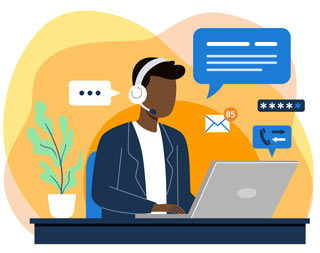
Customer service includes service channels such as agent support (e.g., phone, email, chat, text messaging) and self-service (e.g., interactive voice response, website, chatbot, and social media). Agent and self-service channels play an essential role in the overall customer relationship with an organization and brand. In many cases, contact centers are responsible for all agent and self-service channels.
At SQM Group, we agree with Blake Morgan, who suggests significant differences between customer service, customer care, and customer experience (CX). Morgan describes customer service as assisting customers on how to best use a product, troubleshooting any issues, and ensuring they had a great buying experience. On the other hand, customer care focuses on achieving an emotional connection and how well they interact with an organization. CX is the overarching sum of all interactions; conversely, customer service and customer care are pieces of that puzzle.
Figure 1 is an illustration of differences in customer service, customer care, and customer experience. For example, a call center's customer service moments of truth (MoT) consists of 1. Connecting, 2. Understanding, 3. Helping, 4. Caring and 5. Resolving. The caring MoT could be best described as customer care because an effective agent focuses on showing empathy and building a rapport to make an emotional connection with a customer. Moreover, when caring Mot is effectively delivered, it enhances the customer service. The customer experience is based on the lifecycle stages of interactions (e.g., brand awareness, purchasing, onboarding, servicing, and renewing). Furthermore, the customer journey is another way to describe CX interactions using service channels.
Figure 1: Customer Service vs. Customer Care vs. Customer Experience
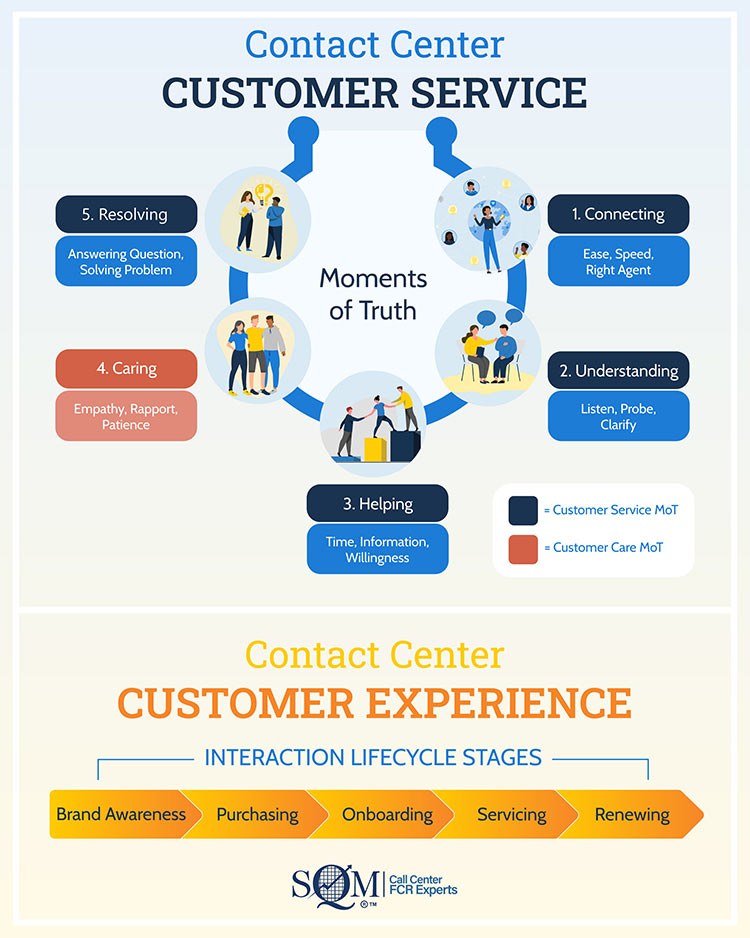
The Importance of Great Customer Service
Customer service is the most critical component of a call center. It offers assistance to customers before, during, and after they purchase a product or service. Your organization might have excellent products and low cost, but if your customer service is poor, it will negatively affect your overall customer relationships, brand, and image.
In addition, customer service is important because if it is great, a call center can improve customer and employee satisfaction, lower operating costs, reduce customers at risk of defection, increase opportunities to sell, and the transactional Net Promoter Score® (NPS).
Interestingly, at the C-level, the FCR rate is almost completely ignored as the driver for achieving great customer service for the call center, even though customers indicated that FCR made the most significant difference to their positive customer service experience.
SQM's contact center Voice of the Customer (VoC) post-contact survey research is illustrated in figure 2 and is followed by the corresponding detailed findings. The data speaks to the importance of VoC FCR for delivering great customer service.
Figure 2: Great Customer Service Research Findings
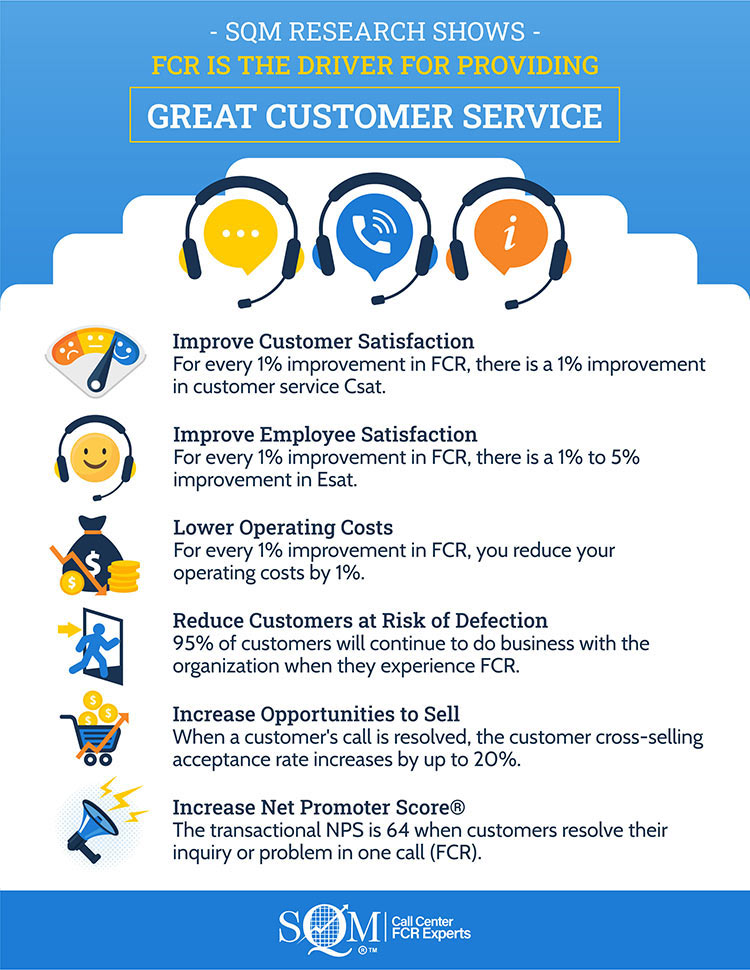

Customer satisfaction (Csat) average drops 15% (top box response) every time a customer calls back to get their initial call resolved. So for every 1% improvement in FCR, there is a 1% improvement in customer service Csat. Moreover, FCR is the highest correlated metric of all call center internal or external metrics to customer service Csat. Put differently, FCR and call resolution are the strongest drivers for delivering great customer service. Therefore, you can make a strong business case that FCR is a proxy for great customer service.

The level of stress is very high for the agent who handles the second or third call when a customer's issue was not resolved on the initial call. Most call center managers understand that high employee satisfaction (Esat) can provide high customer service Csat, but high Csat can also drive high Esat. So for every 1% improvement in FCR, there is a 1% to 5% improvement in Esat.

For a call center performing at the FCR industry average of 70%, potentially 30% of customers will have to call back because their issue was not resolved on the first call. So for every 1% improvement in FCR, you reduce your operating costs by 1%. In addition, repeat calls represent 23% of the average call center's operating budget, which is an enormous opportunity to reduce a call center's operating costs.

When it took repeated calls to resolve their call, 9% of those customers expressed their intent to defect. However, an alarming 25% of customers said they intended to defect when the calls were unresolved. It is worth mentioning that 12% of calls go unresolved for the call center industry average. Conversely, 95% of customers will continue to do business with the organization when they experience FCR.

Focusing on business needs versus customer needs can cause the fundamental customer relationship to be undermined. For example, the customer typically becomes irritated if the agent cross-sells before resolving the inquiry or problem. However, when a customer's call is resolved, the customer cross-selling acceptance rate increases by up to 20%. Put differently, when an agent resolves a call, they feel they have earned the right to cross-sell in many cases.

The transactional Net Promoter Score (NPS) goes down by 18 points for each additional call to resolve an inquiry or problem. NPS is an alarming -10 when a customer's call is unresolved. NPS was 40 when customers resolved their call in two calls. However, the transactional NPS is 64 when customers resolve their inquiry or problem in one call (FCR). Thus, FCR is a strong driver for higher transactional NPS.
Customer Service Measurement
The only way to know the customer service your service channels are delivering is to measure it. Conducting relationship surveys and transactional surveys is vital in enabling an organization to evaluate if a service channel contributes to customer loyalty, reduces operating costs, and identifies opportunities to improve customer service. You can approach this in a few ways, including tracking and benchmarking the below-common customer service metrics.
The Difference Between Relationship Survey and Transactional Survey
Relationship surveys are typically sent at regular and predefined intervals. They provide insights into customer satisfaction with the overall relationship with an organization and brand. Moreover, they generate strategic information to make decisions about which business areas need to improve CX.
Transactional surveys are triggered (within one day) after using a contact channel touchpoint. They provide insights for customer satisfaction with a contact channel. Furthermore, they generate tactical information to action for making contact channel CX improvements.
You can approach customer service measurement in a few ways, including tracking and benchmarking the below-standard customer service metrics.
CX Greatness
In his bestselling management book Good to Great, author James Collins suggests, "greatness is not a function of circumstance. Greatness, it turns out, is essentially a matter of conscious choice and discipline." Furthermore, he states that "good is the enemy of great because it is one of the key reasons, so few companies become great."
At SQM, we believe that call centers need to measure their customer service impact on the overall customer relationship with the organization. There are many VoC metrics that a contact center can use to determine if they are providing great customer service (sometimes described as world-class customer service). At SQM, to effectively assess if a call center delivers great customer service, we conduct a post-contact survey within 1 business day of the interaction using phone, IVR, and email survey collection methods. We use the following customer service survey question to determine if a call center has provided great customer service:
Based on your recent call center experience, how would you rate your overall relationship with the organization?
- Great
- Good
- Average
- Poor
- Or, very poor
In figure 3, SQM research shows that the benchmark average for customer service for the "greatness rating" (top box response) in the call center industry is 53%. Of the over 500 call centers, SQM benchmarks on an annual basis, only 5% of them achieved our world-class customer service standard of 65% or higher greatness (top box response) rating. Put simply, CX greatness can be defined as the world-class standard of 65% or higher top box great rating response.
Moreover, most call centers' SQM measures for customer service would be classified as good performers. Therefore, you could argue that good customer service is also the enemy of the call center industry because they are not motivated to be great at service delivery. Furthermore, SQM research shows that the greatness rating on average drops by 14% top box response for each additional call made to a call center trying to resolve an inquiry or problem.
Figure 3: Call Center Industry Customer Service Rating
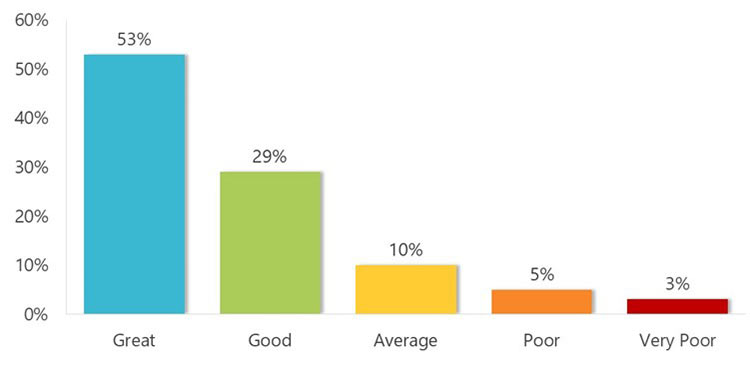
Call Center Csat
Call Center Csat is based on a customer's experience trying to resolve an inquiry or problem. The benchmark average for the call center Csat very satisfied (top box rating response) metric is 77%, and a world-class standard is 85%. Csat has been the most widely used and understood customer service metric of all the VoC metrics. Perhaps the popularity of Csat is because it has been used for many years. At SQM, we recommend measuring Csat at the individual service channel level and the enterprise-wide level. SQM uses a 4-point satisfaction scale with "very satisfied" anchoring the highest point of the scale and "very dissatisfied" anchoring the lowest end of the scale. For Csat, SQM uses the top box response for benchmarking purposes because anything less than Csat top box response represents an opportunity for improvement.
Net Promoter Score® (NPS®)
Net Promoter Score® (NPS®) metric is widely used by leading North American companies. In many cases, it is the most critical metric they use for measuring CX and understanding the impact that CX has on customers' likelihood to recommend the organization to others. The benchmark average for the transactional NPS® metric is 41%, and a world-class standard is 55% for customers who used a service channel. On average, contact centers' management groups manage or share ownership of six service channels and, as a result, are responsible for customer service on most, if not all, interactions a customer has with an organization. Therefore, contact centers significantly impact customers referring the organization to others. The NPS metric can be used on relationship surveys and transactional surveys methods.
First Contact Resolution (FCR)
FCR is based on the percentage of customers who resolved their inquiry or problem on their first contact using a specific service channel, such as a call center, web self-service, IVR self-service, email, or chat. FCR does not take into consideration whether or not other service channels were used. The term 'contact' can be replaced with the specific contact channel (e.g., 'first call resolution, 'first email resolution,' 'first web self-service resolution,' or 'first IVR self-service resolution').
Many SQM clients consider FCR to be their most important CX metric for measuring and managing CX. The benchmark average for the FCR metric is 71%, and a world-class standard is 80%. This means that nearly one-third of customers have to contact the contact center again to resolve their inquiry or problem, which, for most organizations, represents a considerable opportunity to improve.
No matter what customer service measurement metric you use, an open-ended question should be used to identify opportunities to improve customer service to get the most out of the customer survey feedback.
VoC Closed-Loop Process
If customers take the time to provide feedback to help contact centers improve service, organizations should close the loop with customers. Put simply, after receiving the customer feedback, action it and share it with customers and employees.
A VoC closed-loop process identifies service gaps by capturing customer survey feedback and ends with actioning customer feedback. What is important is that people, processes, policy, and technology improvements made to improve customer service are verified by the customer that they improved their customer journey. The VoC closed-loop process can be applied to all service channels.
Contact center leaders are increasing investments in VoC programs and software that employ a VoC closed-loop process. At SQM, our VoC closed-loop process consists of four steps – Identify, Develop, Check, and Act (IDCA) to improve FCR and customer service performance. The four ongoing sequential steps of our IDCA VoC closed-loop process are:
Identify - Repeat call reasons to improve by measuring FCR and Csat performance
Develop - A solution and implement a test pilot to reduce repeat contact reasons
Check - To see if the test pilot was successful by measuring changes in FCR, Csat, and NPS
Act - on customer feedback by implementing a standardized improvement plan for reducing repeat contact reasons for the entire contact channel
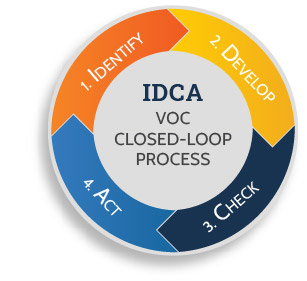
Tips for Improving Customer Service
Great customer service is delivered by connecting, understanding, helping, caring, and resolving their inquiry or problem before, during, and after purchase of a product or service is made. Below are tips for improving and providing great customer service based on MoT that matter the most to customers using a call center.
Customer Service MoT that Matter the Most

Connect Me – Customer is easily connected to the right agent on the first attempt by experiencing quick access to an agent and a user-friendly voice menu system.
Understand Me – Agent determines and confirms the reason(s) for the customer's call by actively listening, probing, and clarifying to ensure understanding and acknowledging call history and documenting the conversation. Good knowledge of the customer's situation allows an agent to provide a personalized solution.
Help Me – Agent expresses and demonstrates a willingness to help customers by letting them know they can help them, providing accurate and complete information, focusing on the inquiry, taking the necessary time to help the customer, and educating them with solution options.
Care About Me – Agent uses a friendly, enthusiastic, polite, and warm voice tone, builds rapport, shows empathy for the customer's situation, is patient and honest, and expresses appreciation for the customer's business.
Resolve Me – Agent resolves customer's inquiries or problems by answering questions, solving problems, using authority and taking ownership, providing fair treatment, summarizing calls, communicating next steps, and confirming that the call is resolved.
Top Five Business Practices for Improving Customer Service
SQM Group has been measuring, benchmarking, tracking, and helping leading North American call center's improve First Call Resolution and Customer Service for over 25 years. We benchmark the FCR rate and evaluate business practices (e.g., people, process, and technology) with over 500 call centers annually to determine the best practices for improving customer service. Again, it is essential to emphasize that improving FCR enhances customer service. Listed below are the five most helpful business practices for improving FCR and customer service according to SQM clients:
-
Management focuses on improving FCR
-
Post-call customer surveying
-
Focused FCR training (agent new hire and ongoing training)
-
Streamlining business practices through software applications
-
Incorporating Csat/call resolution into the quality assurance program

mySQM™ FCR Insights Software
Find out why over 500 leading North American contact centers trust mySQM™ FCR Insights Software as a best practice to measure and improve First Contact Resolution. Our software provides First Contact Resolution insights by capturing and reporting external (e.g., post-contact surveys) and internal (e.g., call data, quality assurance) data, all in one powerful First Contact Resolution software platform. In addition, our high-value software is specifically built to help contact channels improve their CX and operating costs. As a result, our client's average ROI is 450%, and the payback period is less than 3 months.
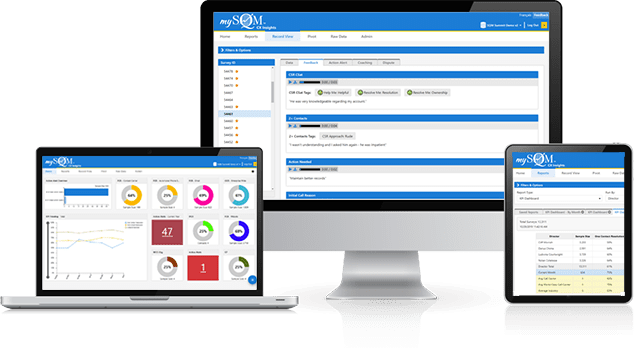
Quick Related Links
First Call Resolution Definition First Call Resolution PPT First Call Resolution Benefits
First Call Resolution Strategies First Call Resolution Operating Philosophy FCR Case Study Survey Data Calculate First Call Resolution 5 Benefits of Journey Mapping CX Pulse Check Top 10 CX Metrics FCR Strategy Options VoC Closed-Loop Outside-in or Inside-Out Journey Mapping
